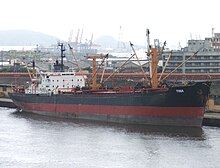Standard ship
A standard ship , also series ship or unit ship , is a ship that is or has been built in large numbers according to a joint design. Standard ships are characterized by a more or less comprehensive construction similarity, which often also includes the same machines and equipment. The term standard ship is also used in the broader sense for a particularly widespread or average type of ship, for example within a market, transport or research segment.
history
The earliest large-scale standard ship designs were the various types of World War I built in Great Britain ( War Ships ) and the United States ( Hog Islander ) , the production of which was based on government planning. In the years between the two world wars, it was primarily the shortage of money as a result of the global economic crisis that led to the development of civilian standard ship types that could be built and operated cheaply (for example the Doxford economy ship ). The time of the Second World War saw the state-controlled construction of standard ships both on the part of the Allies and in Germany (the Liberty and Victory standard freighters became particularly well known on the Allied side , the ships of the Hansa building program on the German side ). After the end of the war, the Long Range Merchant Shipbuilding Program continued in the United States , which consisted of numerous standardized ship types. Although this shipbuilding program consisted of merchant ships, it also had a military background. A larger number of standard civilian ship types were built from the mid-1960s. In tramp shipping , around 700 of the 3300 Liberty and Victory ships produced, as well as some other cargo ships built during the Second World War, were in the world merchant fleet of that time. Even the youngest of them were now 20 years and older and would be reaching the end of their service life in the foreseeable future. Numerous shipyards offered Liberty replacement ship types at this time . The design of these ships was based on the Liberty ships to be replaced, as the great upheavals in maritime traffic, caused by the appearance of container ships and bulk carriers , which would later almost completely replace the general cargo ships, could not yet be foreseen at this point in time. The mostly very successful ship series (for example SD-14 , Freedom or German Liberty ) were built until the late 1980s, in some cases with substantial adaptations, and the subsequent types based on them in some cases even beyond. Until the 1990s, the trend towards building large series of real standard ships had weakened, but Asian shipyards in particular continue to offer a large number of standard types in bulk, tank and container shipbuilding, some of which are still available in series up to 400 units were produced.
Standard ships in the West German inland navigation
In the time after the Second World War, a large part of the units destroyed or damaged in the war had to be replaced in German inland navigation . For this purpose, the Technical Committee of the Central Association for German Inland Shipping resumed its work that had been interrupted during the war and, in cooperation with the Federal Ministry of Transport, developed five standard ship types adapted to certain canal dimensions , which are exclusively self-propelled, i.e. H. ships equipped with their own propulsion system acted. ( Johann-Welker-Schiff , Gustav-Koenigs-Schiff , Oskar-Taubert-Schiff , Karl-Vortisch-Schiff , Theodor-Beyer-Schiff ).
In the years that followed, numerous inland vessels were built on the basis of the five standard vessel types for West German inland navigation.
literature
- Alfred Dudszus, Alfred Köpcke: The big book of ship types . Weltbild Verlag, Augsburg 1995, ISBN 3-89350-831-7 .
- Robert Scott: Standard Ship Designs: Dry cargo, container and ro-ro vessels . Fairplay Publications, London 1984, ISBN 0-905045-54-8 .
- Hans Jürgen Witthöft: The Hansa building program (= military science reports . Volume 6 ). JF Lehmanns, Munich 1968.
- Armin Wetterhahn: US standard cargo and passenger ships 1938–1956 . Eckardt & Messtorff, Hamburg 1957.
- US Division of Naval Intelligence (Ed.): Standard Classes of Japanese Merchant Ships . ONI 208-J, Supplement January 3, 1945 ( ibiblio.org [PDF]).
Individual evidence
- ^ Jörg Schneider: Empirical studies on the influence of freight rates, freight income and shipbuilding prices on the construction of sea freight ships 1900-1958 . In: Transport Science Research , Volume 6. Universität Hamburg, Hamburg, 1961.
- ↑ Peter Broers: The structural changes in German shipping . Duncker & Humblot, 1974, ISBN 3-428-03075-3 .
- ^ Martin Stopford: Maritime Economics . Routledge, Oxon / New York 1997, ISBN 0-415-15310-7 .

